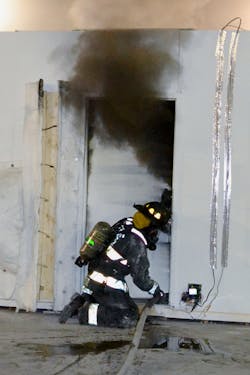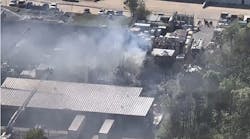Over the past decade, the fire service has placed an increasing emphasis on fire dynamics and how tactical choices affect fire development. Research has verified that residential structures provide compartmentation, which limits the available oxygen for combustion and, in turn, limits the fire’s size (heat release rate).
In a single-story 1,200-square-foot ranch home, with modern furnishings and no open windows or doors, the fire will begin to run out of oxygen at around 5 minutes. In a two-story 3,200-square-foot colonial home, the amount of oxygen is greater due to the larger floor plan; however, with modern furnishings and no open windows or door, the fire begins to run out of oxygen in about 7 minutes, 30 seconds (Figure 1). When this is compared to legacy construction furnishings, the time to ventilation limited was approximately 19 minutes.1,2,3
The National Fire Incident Reporting System (NFIRS) database tracks response time along with incident type. From 2006 to 2009, the average response time for a single-family residential structure was approximately 6 minutes, 24 seconds, not including the time from the 9-1-1 call to the time of dispatch4 (Table 1). When the average response time is compared to fire development in modern furnishings, the reality is that the initial company is arriving after the fire has become ventilation limited. Even with an open front door, the fire is reaching a ventilation-limited state in 7 minutes.3 If initial companies are arriving to a ventilation-limited fire, how does this affect their incident priorities and the order of operations?
Door control
Whether conducting search and rescue or engaging in suppression, crews need to gain access to the structure. With a ventilation-limited structure fire, gaining access creates additional openings, which provides more oxygen, allowing the fire to grow. This includes opening the front door. Unless other actions are taken, the fire will increase in size until it reaches its new ventilation-limited state. It has been shown that in a single-story, 1,200-square-foot structure, this growth resulted in the environment near the fire exceeding the temperature a firefighter could survive, with full protective gear, within 100 seconds. And in a 3,200-square-foot structure, the growth took 200 seconds (Figure 2).1,2
When gaining entry, as either the search or suppression crew, controlling the size of the opening made will limit the impact the additional oxygen has on the fire growth. Door control is an effective tactic to limit the opening size on a door that has been forced for entry. Door control involves limiting the open area of the door in order to limit the amount of air and oxygen that can get to the fire and ultimately affect its size.
This tactic has proven effective in both single-story and two-story structure residential structures. During the 2010 UL Study on Vertical Ventilation,2 two experiments were conducted in the single-story structure—one where the door was opened completely and a second where the door was controlled. Door control was defined as closing the door only enough as to not impede a hoseline advancing straight through the door (Figure 3).
The temperature at 3 feet, approximately the crawling height of a firefighter, was compared for the two experiments. Figure 4 shows the temperature of the open-door experiment in red and the door control experiment in blue. The chart starts from the time the door was opened at 8 minutes, where conditions were similar. The temperature at 3 feet in the open-door test reacts in approximately 30 seconds to the additional oxygen, increasing and rapidly approaching the tenability limits of structural fire gear in just over 1 minute, 30 seconds. In contrast, the door control tests takes over 4 minutes to reach the same temperature. Controlling the door delayed the fire development, giving crews an addition 3 minutes to conduct operations before temperatures approached hazardous conditions for interior crews.
In addition to the single-story tests, two experiments were performed in the two-story structure looking at the impact of the larger structure on the effectiveness of the tactic. Figure 5 shows the temperature at 3 feet, approximately the crawling height of a firefighter, for both experiments.
The use of door control in the two-story structure proved more effective than the single-story case. Due to the larger volume, and distance between the front door and fire, the air entering needed to travel farther to reach the fire. As the air traveled through the structure, it mixed with the smoke, resulting in a minimal amount of oxygen reaching the fire. Without the additional oxygen, the fire remained at the same temperature and did not develop further.
Additional points
These four experiments show how applying door control during interior operations can limit the fire development, giving crews more time to accomplish their tactical objectives. However, the action of door control is temporary. Once water is being applied to the fire, absorbing energy and transitioning it from a ventilation-limited to a fuel-limited fire, the door should be opened fully. Opening the door provides the most efficient flow, cooling the environment and removing the smoke. Tactically, this may mean a dedicated firefighter holding the door in the controlled position until it is identified that water is being applied to the fire.
Additionally, if the initial companies are able to apply water quickly, for example in a transitional attack, the action of door control is not needed. The transitional attack absorbs the energy the fire is producing, taking it from its ventilation-limited state to a fuel-limited state. This same concept applies when water is applied through the front door into the fire compartment, before making entry. However, if the location of the fire is not known, and water can’t be applied directly to the fire compartment, the use of door control as a tactic is an effective method of delaying the fires growth while gaining access to a ventilation-limited fire.
References
1. Kerber, S. “Impact of Ventilation on Fire Behavior in Legacy and Contemporary Residential Construction.” December 2010. Underwriters Laboratories.
2. Kerber, S. “Study of the Effectiveness of Fire Service Vertical Ventilation and Suppression Tactics in Single Family Homes.” 2013. Underwriters Laboratories.
3. Zevotek, R. and Kerber, S. “Study of the Effectiveness of Fire Service Positive Pressure Ventilation During Fire Attack in Single Family Homes Incorporating Modern Construction Practices.” 2016. Underwriters Laboratories.
4. Kerber, S. “Analysis of Changing Residential Fire Dynamics and Its Impact on Firefighter Operational Timeframes.” Underwriters Laboratories.






